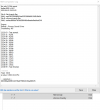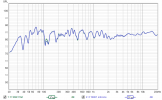neutralguy
Member
- Joined
- Apr 16, 2019
- Messages
- 68
- Likes
- 157
My Salon2s had long been sitting flat on my hardwood floor, whereas the manufacturer recommends using the supplied spikes. Do speakers supports matter so much that it's worth potentially damaging my floors and raising an already high tweeter? Intuitively a compliant support such as blutack or silicone pads could absorb some of the cabinet's vibrations. Wouldn't that be better for the sound anyway? I had done an investigation previously using my Revel M105 speakers on a desk, a setup much more susceptible to vibration, and found that silicone resulted in the lowest vibration to both speaker and desk, beating out spikes and flat placement with no spikes. Here I report on a similar experiment on my Salon2s.
To measure vibration, I used an AKG C411 vibration microphone as an accelerometer. When attached to say a guitar, the C411 turns the instrument's vibrations into electrical signals for amplification. Mounting the tiny C411 using blutack onto the Salon2 and using it as mic input for REW, it measures the speaker cabinet's vibrations as the speaker plays REW's sine sweep. I took measurements from two spots on the front baffle, near the Salon2's upper bass driver (baffle bass) and near the tweeter (baffle tweeter). Here's how it looks when mounted on baffle tweeter.

I compared two placement options, flat (speaker touching floor) and silicone (pads between speaker and floor). I did not test spikes because my previous measurements using a M105 showed spikes to yield even more vibrations than flat, so I wasn't going to spike my floors with a 130lb weight. First is the results of the vibration measurements on the speaker baffle.

Absolute decibels here do not correspond to sound levels, as these are surface vibrations. What we focus on is relative differences. "C411 noise baseline" is the microphone's response when speakers are muted. All traces show some vibration above baseline. The most drastic difference between the two mounting options is between 100-200hz. There's a massive bump of around 20db peaking at 115hz at baffle tweeter for flat vs silicone, and a lesser bump at baffle bass. 20db suggests a 100x difference in vibrational energy. Where did this upper base energy go? To check whether it could have been transferred to the floor, I took vibration measurements of the floor 6 inches in front of the speaker.

There does not apppear to be large differences in floor vibration. There may be a small difference in the high frequencies, but around 100-200hz it looks very close, with silicone vibrating less if anything.
I also took vibration measurements at the middle of the speaker's side panel.

The differences here are more minor. There is a small bump around 50hz for silicone, but as we see below this difference does not appear significant enough to affect the output sound. If using a subwoofer the Salon2 would be alleviated of duties at this frequency anyway.
Let's now look at how the sound output is affected. These frequency response measurements were taken 6 feet in front of the speaker, upper midrange axis, using a Shure SM81 microphone for reasons explained below. Its response for this purpose is very close to my calibrated UMIK1 except for a moderate bass rolloff.

We see that flat and silicone are basically the same except around 115hz. Zooming in:

We see a 1.5db bump around 115hz for flat. Given the above measurements showing the baffle vibrating 20db more for flat, I'm going to assume that this bump is due to additional contribution from baffle vibrations. As such, I assume the bump is undesired.
Since vibrations of the cabinet and floor, as well as the sound output, are all equal or reduced for silicone, my conclusion is the cabinet's vibrational energy at 100-200hz must have been absorbed by silicone pads and turned into heat. Sounds like a good thing to me.
But how does this affect the sound subjectively? If I came on ASR and said these $5 pads with a 1.5db Q=5 effect cleared up the midrange and upper bass, I might be laughed off the forum and called a snake oil salesman. Even I doubted what I was hearing, which was a fairly noticeable difference. Swapping the pads in and out takes too much time and effort for an ABX test, so what to do?
This is where the SM81 comes in. I placed a pair of level matched Shure SM81 microphones, 2' in front of each Salon2's tweeter, and recorded them playing music in stereo. This microphone was chosen for its low noise and flat frequency response. Its cardioid pattern helps reduce sound from room reflections. The recorded files, which sound surprisingly good with stereo imaging intact, were played back on speakers using Foobar's ABX plugin. On a sample of music I'm familiar with (a Bach concerto), I was correct 14 out of 16 trials (p = 0.0021), with almost no practice. If this forum allowed it I can upload the recorded files and everyone can try too.

I distinguished a difference by listening for exactly where the measurements showed differences, in the upper bass. The flat placement recording seems to have extra oomph and bloom in that region. The difference is minor, but if it can be discerned even through distortions of the recording process, in all likelihood the actual difference is at least as audible or even more so. While ABX proves a difference audible to at least one person, it does not mean it will be preferred to an average listener. I do think silicone definitely sounds better in my listening, but I may be biased from being aware of the measurement results.
TLDR
My main takeaways from this experiment:
1. Silicone pads placed under Revel Salon2 on a hardwood floor, compared to flat placement, reduces vibration between 100-200hz and makes a measurable and audible difference. They can be found on Amazon.
2. Using a vibration microphone can show significant differences for a seemingly minor tweak. Correlation with regular frequency response measurements of sound suggests these vibration measurements are relevant to sound output.
3. Recording speaker output and using Foobar's ABX comparator on the recorded sound can show audibility for a tweak that otherwise seems minor.
To measure vibration, I used an AKG C411 vibration microphone as an accelerometer. When attached to say a guitar, the C411 turns the instrument's vibrations into electrical signals for amplification. Mounting the tiny C411 using blutack onto the Salon2 and using it as mic input for REW, it measures the speaker cabinet's vibrations as the speaker plays REW's sine sweep. I took measurements from two spots on the front baffle, near the Salon2's upper bass driver (baffle bass) and near the tweeter (baffle tweeter). Here's how it looks when mounted on baffle tweeter.
I compared two placement options, flat (speaker touching floor) and silicone (pads between speaker and floor). I did not test spikes because my previous measurements using a M105 showed spikes to yield even more vibrations than flat, so I wasn't going to spike my floors with a 130lb weight. First is the results of the vibration measurements on the speaker baffle.
Absolute decibels here do not correspond to sound levels, as these are surface vibrations. What we focus on is relative differences. "C411 noise baseline" is the microphone's response when speakers are muted. All traces show some vibration above baseline. The most drastic difference between the two mounting options is between 100-200hz. There's a massive bump of around 20db peaking at 115hz at baffle tweeter for flat vs silicone, and a lesser bump at baffle bass. 20db suggests a 100x difference in vibrational energy. Where did this upper base energy go? To check whether it could have been transferred to the floor, I took vibration measurements of the floor 6 inches in front of the speaker.
There does not apppear to be large differences in floor vibration. There may be a small difference in the high frequencies, but around 100-200hz it looks very close, with silicone vibrating less if anything.
I also took vibration measurements at the middle of the speaker's side panel.
The differences here are more minor. There is a small bump around 50hz for silicone, but as we see below this difference does not appear significant enough to affect the output sound. If using a subwoofer the Salon2 would be alleviated of duties at this frequency anyway.
Let's now look at how the sound output is affected. These frequency response measurements were taken 6 feet in front of the speaker, upper midrange axis, using a Shure SM81 microphone for reasons explained below. Its response for this purpose is very close to my calibrated UMIK1 except for a moderate bass rolloff.
We see that flat and silicone are basically the same except around 115hz. Zooming in:
We see a 1.5db bump around 115hz for flat. Given the above measurements showing the baffle vibrating 20db more for flat, I'm going to assume that this bump is due to additional contribution from baffle vibrations. As such, I assume the bump is undesired.
Since vibrations of the cabinet and floor, as well as the sound output, are all equal or reduced for silicone, my conclusion is the cabinet's vibrational energy at 100-200hz must have been absorbed by silicone pads and turned into heat. Sounds like a good thing to me.
But how does this affect the sound subjectively? If I came on ASR and said these $5 pads with a 1.5db Q=5 effect cleared up the midrange and upper bass, I might be laughed off the forum and called a snake oil salesman. Even I doubted what I was hearing, which was a fairly noticeable difference. Swapping the pads in and out takes too much time and effort for an ABX test, so what to do?
This is where the SM81 comes in. I placed a pair of level matched Shure SM81 microphones, 2' in front of each Salon2's tweeter, and recorded them playing music in stereo. This microphone was chosen for its low noise and flat frequency response. Its cardioid pattern helps reduce sound from room reflections. The recorded files, which sound surprisingly good with stereo imaging intact, were played back on speakers using Foobar's ABX plugin. On a sample of music I'm familiar with (a Bach concerto), I was correct 14 out of 16 trials (p = 0.0021), with almost no practice. If this forum allowed it I can upload the recorded files and everyone can try too.

I distinguished a difference by listening for exactly where the measurements showed differences, in the upper bass. The flat placement recording seems to have extra oomph and bloom in that region. The difference is minor, but if it can be discerned even through distortions of the recording process, in all likelihood the actual difference is at least as audible or even more so. While ABX proves a difference audible to at least one person, it does not mean it will be preferred to an average listener. I do think silicone definitely sounds better in my listening, but I may be biased from being aware of the measurement results.
TLDR
My main takeaways from this experiment:
1. Silicone pads placed under Revel Salon2 on a hardwood floor, compared to flat placement, reduces vibration between 100-200hz and makes a measurable and audible difference. They can be found on Amazon.
2. Using a vibration microphone can show significant differences for a seemingly minor tweak. Correlation with regular frequency response measurements of sound suggests these vibration measurements are relevant to sound output.
3. Recording speaker output and using Foobar's ABX comparator on the recorded sound can show audibility for a tweak that otherwise seems minor.

